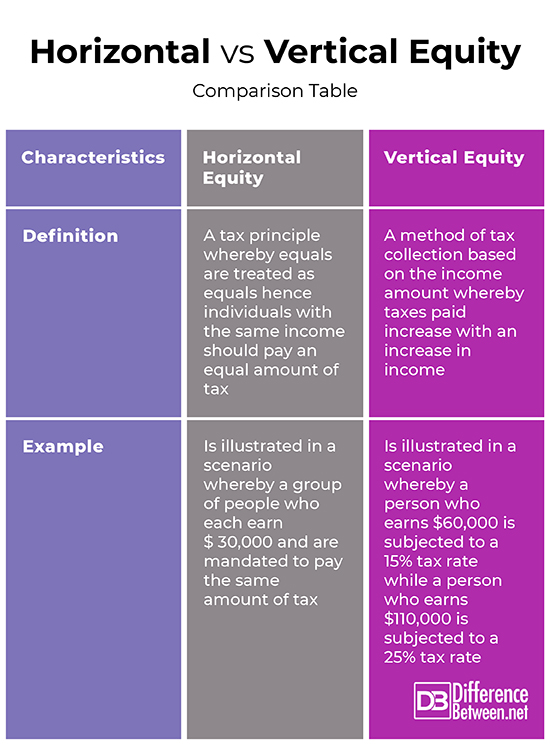Difference Between Horizontal Equity and Vertical Equity
For government entities to fund public projects, individuals are mandated to pay a certain amount of funds, commonly referred to as taxes. Failure to pay through resistance or evasion is prohibited and is punishable by law. Authorities are hence tasked with the role of collecting taxes, with most countries having functional tax systems. Among the subunits that attract tax include properties, gifts, estates, wealth, inheritance, payrolls, and sales, just to name a few. While taxes are mandatory, the systems used should be fair. The two types of equity distributions commonly used include vertical and horizontal equity.
What is Horizontal equity?
This is a tax principle whereby equals are treated as equals hence individuals with the same income should pay an equal amount of tax. This method purely works based on figures and eliminates discrimination based on race, gender or profession. This system is, however, hard to implement as difficulties arise in the attempt to categorize individuals based on equal access to wealth and resources. For instance, if a group of people each earn $ 30,000, they should pay the same amount of tax.
What is Vertical equity?
Also referred to as the ability to pay tax principle, this is a method of tax collection based on the income amount whereby taxes paid increase with an increase in income. Persons with more income, resource access and wealth are hence required to pay more than those who have less, through progressive and proportional tax rates. This is effected through progressive taxation whereby people with higher income brackets pay higher tax rates based on the income brackets. The revenue collected is then used to fund government projects. For example, a person who earns $60,000 is subjected to a 15% tax rate while a person who earns $110,000 is subjected to a 25% tax rate.
Similarities between Horizontal and Vertical Equity
- Both are equity distribution methods
- Both are affected by the means under which income is taxed
Differences between Horizontal and Vertical Equity
Definition
Horizontal equity is a tax principle whereby equals are treated as equals hence individuals with the same income should pay an equal amount of tax. On the other hand, vertical equity is a method of tax collection based on the income amount whereby taxes paid increase with an increase in income.
Example
An example of horizontal equity is illustrated in a scenario whereby a group of people who each earn $ 30,000 and are mandated to pay the same amount of tax. On the other hand, an example of vertical equity is illustrated in a scenario whereby a person who earns $60,000 is subjected to a 15% tax rate while a person who earns $110,000 is subjected to a 25% tax rate.
Horizontal vs. Vertical Equity: Comparison Table
Summary of Horizontal vs. Vertical Equity
While horizontal equity is a tax principle whereby equals are treated as equals hence individuals with the same income should pay an equal amount of tax. It ensures there is no discrimination based on gender, work type or race. On the other hand, vertical equity is a method of tax collection based on the income amount whereby taxes paid increase with an increase in income and ensures there is an equal redistribution of wealth in the society.
- Difference Between Profit Center and Investment Center - July 2, 2022
- Difference Between Anti-Trust and Anti-Competition - June 6, 2022
- Difference Between Stocktaking and Stock Control - June 6, 2022
Search DifferenceBetween.net :
Leave a Response
References :
[0]Gravelle J & Cordes J. The Encyclopedia of Taxation & Tax Policy. The Urban Insitute Publishers, 2005. https://books.google.co.ke/books?id=XsGdBReOQSgC&printsec=frontcover&dq=Difference+between+Horizontal+and+Vertical+Equity&hl=en&sa=X&ved=0ahUKEwj43c24nJPkAhUxx4UKHZzMBaQ4ChDoAQgqMAE#v=onepage&q=Difference%20between%20Horizontal%20and%20Vertical%20Equity&f=false
[1]Bernard Salanié. The Economics of Taxation. MIT Press, 2011. https://books.google.co.ke/books?id=UYb6AQAAQBAJ&printsec=frontcover&dq=Difference+between+Horizontal+and+Vertical+Equity&hl=en&sa=X&ved=0ahUKEwj43c24nJPkAhUxx4UKHZzMBaQ4ChDoAQg0MAM#v=onepage&q=Difference%20between%20Horizontal%20and%20Vertical%20Equity&f=false
[2]Araar A & Duclos Y. Poverty and Equity: Measurement, Policy and Estimation with DAD. Volume 2 of Economic Studies in Inequality, Social Exclusion and Well-Being. Springer Science & Business Media, 2007. https://books.google.co.ke/books?id=TX4_AAAAQBAJ&printsec=frontcover&dq=Difference+between+Horizontal+and+Vertical+Equity&hl=en&sa=X&ved=0ahUKEwjJnZTpm5PkAhULx4UKHdePDVYQ6AEITTAH#v=onepage&q=Difference%20between%20Horizontal%20and%20Vertical%20Equity&f=false
[3]Image credit: https://pixabay.com/de/photos/steuer-formular-irs-steuern-4080693/
[4]Image credit: https://www.flickr.com/photos/68751915@N05/6355404323



